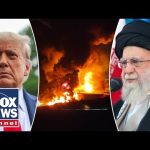In a bold move highlighting ongoing tensions in the Middle East, the Israeli Defense Forces (IDF) have unleashed a series of strikes on strategic Iranian nuclear facilities, causing ripples through the international community. The operations seemed to target key sites that could serve as stepping stones for Iran’s pursuit of nuclear weapon capabilities. The stakes, as illustrated by military and intelligence analysts, are incredibly high, as uncertainty looms over the extent of Iran’s nuclear ambitions and the covert networks they may have established over the past four decades.
One of the prime targets was the Natanz uranium enrichment facility, which, as history tells us, is not just a playground for centrifuges but a critical cog in Iran’s nuclear machine. This facility boasts a significant arsenal of over 12,000 advanced centrifuges, along with a hefty complement of older models. With the IDF’s calculated destruction of Natanz’s power supply, experts postulate that the centrifuges are likely out of commission. Without the proper controls in place, they may have furiously spun to a halt—or worse, they might have crashed spectacularly against their surrounding walls, rendering them useless for the moment.
Meanwhile, the ancient city of Isfahan, with its rich history, has also come under fire, literally and figuratively. This site, initially used for converting uranium ore into a form suitable for enrichment, has pivoted to producing weapons-grade uranium metal in recent years. The IDF reportedly took out four key structures at this complex, sweeping through uranium conversion and metal processing plants, a chemical lab, and a fuel manufacturing facility in Arak. With heavy water nuclear reactors often used for civilian energy purposes while secretly holding the potential for plutonium production, the IDF’s actions raise eyebrows and provoke questions. Could Iran have been on the brink of making significant advancements toward weapons-grade materials?
Despite these strikes in various locations, the elusive Fordow facility—situated deep within a mountain—remains unscathed. Analysts suggest that even massive bunker-buster bombs could be unnecessary for the IDF to effectively disable operations there. Instead, it is believed that the military capabilities of the IDF, honed through years of experience, might be enough to address the challenges posed by this fortified location. The stakes are high, as this facility is home to many of the regime’s nuclear scientific minds, the architects behind Iran’s ambitions for nuclear armament.
As a larger narrative unfolds, policymakers from both the U.S. and Israel continue to express concern over the unknown aspects of Iran’s nuclear program. The crucial question remains: has Iran tucked away stockpiles of highly enriched uranium or advanced centrifuges in secret facilities? The murky depths of uncertainty are daunting, presenting a potential ticking time bomb. Could these clandestine operations pose a clear and present danger to regional and global security if the Ayatollah and his inner circle possess earlier advancements that are yet to be discovered?
With these developments, the focus shifts to the ramifications of the IDF’s actions. The military successes must also be weighed against the wider implications for international diplomacy and security in the region. The eyes of world leaders are undoubtedly glued to the state of Iran’s nuclear program, and the duration of Israel’s ability to maintain and further its efforts will shape the balance of power in an already volatile landscape. As the dust settles, the imperative remains clear: the quest to ensure that nuclear capabilities do not fall into the wrong hands must continue with diligence and resolve.




